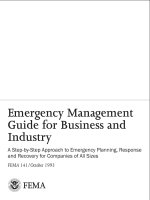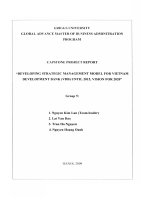Strategic management planning for domestic and global competition 14th ed pearce robinson chapter 4
Bạn đang xem bản rút gọn của tài liệu. Xem và tải ngay bản đầy đủ của tài liệu tại đây (346.8 KB, 35 trang )
Chapter 4
The External
Environment
© 2015 by McGraw-Hill Education. This is proprietary material solely for authorized instructor use. Not authorized for sale or distribution
in any manner. This document may not be copied, scanned, duplicated, forwarded, distributed, or posted on a website, in whole or part.
Learning Objectives
1. Describe the three tiers of environmental factors that affect firm
performance
2. List and explain the five factors in the remote environment
3. Give examples of the economic, social, political, technological, and
ecological influences on a business
4. Explain the five forces model of industry analysis and give examples
of each force
5. Give examples of the influences of entry barriers, supplier power,
buyer power, substitute availability, and competitive rivalry on a
business
6. List and explain the five factors in the operating environment
7. Give examples of the influences of competitors, creditors,
customers, labor, and direct suppliers on a business
External Environment
• The factors beyond the control of the
firm that influence its choice of direction
and action, organizational structure, and
internal processes
The Firm’s External Environment
Comprised of following Components:
• Remote environment
• Industry environment
• Operating environment
Remote Environment
• Economic, social, political, technological,
and ecological factors that originate
beyond, and usually irrespective of, any
single firm’s operating situation.
Ex. 4.1
The Firm’s External Environment
Remote Environment
• Economic Factors
• Social Factors
• Political Factors
• Technological Factors
• Ecological Factors
Economic Factors
1.
2.
3.
4.
5.
6.
Prime interest rates
Inflation rates
Trends in the growth of the gross national product
Unemployment rates
Globalization of the economy
Outsourcing
Social Factors
Present in the external environment:
Beliefs & Values
Attitudes & Opinions
Lifestyles
Developed from:
Cultural conditioning
Ecological conditioning
Demographic makeup
Religion
Education
Ethnic conditioning.
Three Profound Social Changes
• Entry of large numbers of women into the
labor market
• Accelerating interest of consumers and
employees in quality-of-life issues
• Shift in the age distribution of the population
• Cutting across the above three issues is
concern for individual health
Political Factors
Political constraints on firms:
• Fair-trade Decisions
• Antitrust Laws
• Tax Programs
• Minimum Wage Legislation
• Pollution and Pricing Policies
• Administrative jawboning
Impact of Political Activity
• Political activity has a significant impact
on two governmental functions that
influence the remote environment of
firms:
– Supplier function
– Customer function
Technological Factors
•
•
•
Technological forecasting helps protect and
improve the profitability of firms in growing
industries.
It alerts strategic managers to impending
challenges and promising opportunities.
The key to beneficial forecasting of
technological advancement lies in
accurately predicting future technological
capabilities and their probable impacts.
Technological Forecasting
• The quasi-science of anticipating
environmental and competitive changes
and estimating their importance to an
organization’s operations.
Ecological Factors
• Ecology refers to the relationships among
human beings and other living things and the
air, soil, and water that supports them.
Ecological Factors (contd.)
•
Threats to our life-supporting ecology caused
principally by human activities in an industrial
society are commonly referred to as pollution
•
Loss of habitat and biodiversity
•
Environmental legislation
•
Eco-efficiency
Eco-efficiency
• Company actions that produce more
useful goods and services while
continuously reducing resource
consumption and pollution.
Industry Environment
•
Harvard professor Michael E. Porter propelled the
concept of industry environment into the foreground
of strategic thought and business planning.
•
The cornerstone of Porter’s work first appeared in
the Harvard Business Review, in which he explains
the five forces that shape competition in an industry.
•
Porter’s well-defined analytic framework helps
strategic managers to link remote factors to their
effects on a firm’s operating environment.
Industry Environment Defined
• The general conditions for competition that
influence all businesses that provide similar
products and services.
How Competitive Forces Shape Strategy
•
•
•
•
The essence of strategy formulation is coping with
competition.
Intense competition in an industry is neither coincidence
nor bad luck.
Competition in an industry is rooted in its underlying
economics, and competitive forces exist that go well
beyond the established combatants in a particular
industry.
The corporate strategists’ goal is to find a position in the
industry where his or her company can best defend itself
against these forces or can influence them in its favor.
Ex. 4.9
Forces Driving Industry Competition
Threat of Entry
Common Barriers to Entry
•
Economies of Scale
•
Product Differentiation
•
Capital Requirements
•
Cost Disadvantages Independent of Size
•
Access to Distribution Channels
•
Government Policy
Powerful Suppliers
A supplier group is powerful if:
• It is dominated by a few companies and is more
concentrated than the industry it sells to
• Its product is unique or at least differentiated, or if it has
built-up switching costs
• It is not obliged to contend with other products for sale
to the industry
• It poses a credible threat of integrating forward into the
industry’s business
• The industry is not an important customer of the supplier
group
Powerful Buyers
A buyer group is powerful if:
• It is concentrated or purchases in large volumes
• The products it purchases from the industry are standard
• The products it purchases from the industry form a component of its
product and represent a significant fraction of its cost
• It earns low profits
• The industry’s product is unimportant to the quality of the buyers’
products or services
• The industry’s product does not save the buyer money
• The buyers pose a credible threat of integrating backward
Substitute Products
•
By placing a ceiling on the prices it can charge, substitute
products or services limit the potential of an industry
• Substitutes not only limit profits in normal times but also
reduce the bonanza an industry can reap in boom times
• Substitute products that deserve the most attention
strategically are those that are
– subject to trends improving their price-performance
trade-off with the industry’s product or
– produced by industries earning high profits









